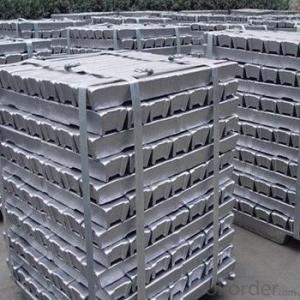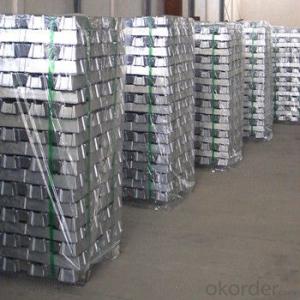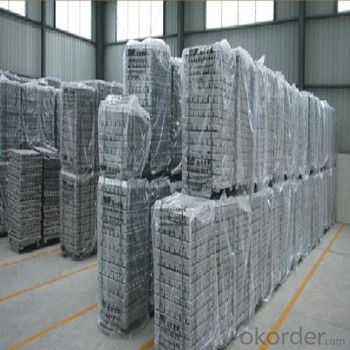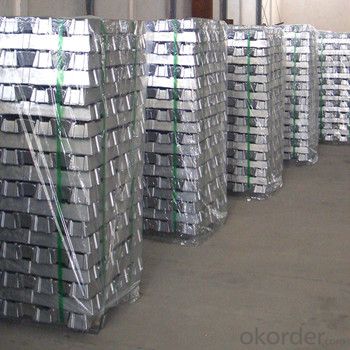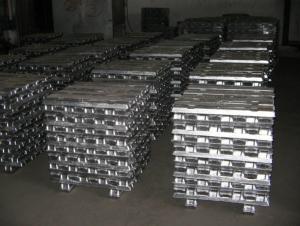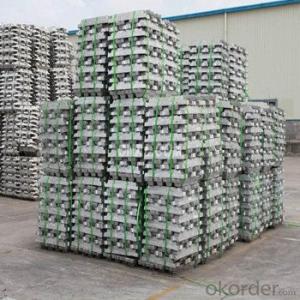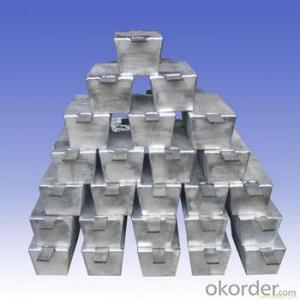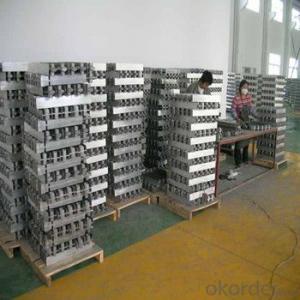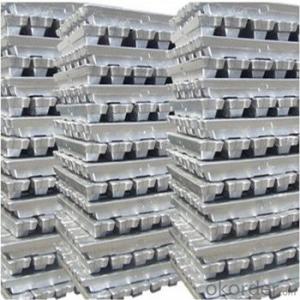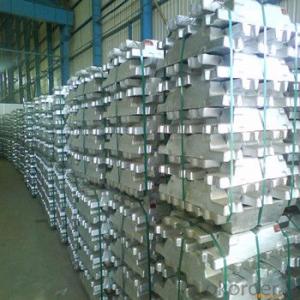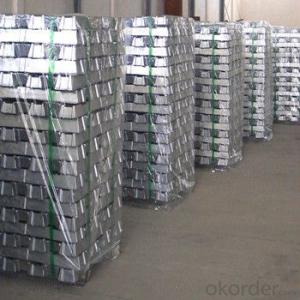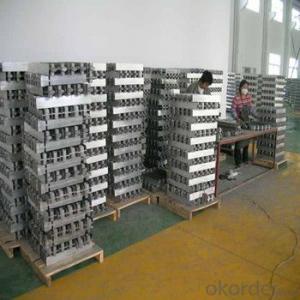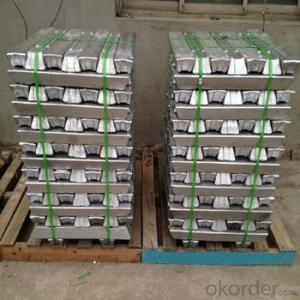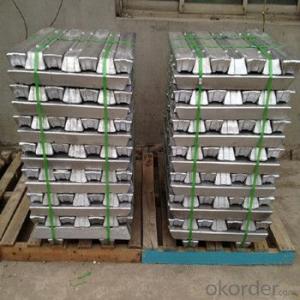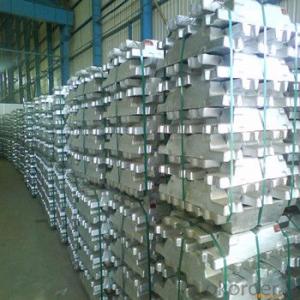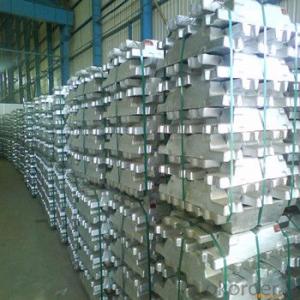Aluminum Pig/Ingot Sold With Wholesale By Mills
- Loading Port:
- China main port
- Payment Terms:
- TT OR LC
- Min Order Qty:
- 1000 m.t.
- Supply Capability:
- 100000 m.t./month
OKorder Service Pledge
OKorder Financial Service
You Might Also Like
Pure Aluminum Pig/Ingot Used for Industry
1.Structure of Aluminum Pig/Ingot
A material that has been cast into a shape in order to be transported and processed easier than in an unprocessed form. An ingot is typically rectangular in shape, which allows it to be stacked. Ingots are most commonly associated with metals, with ingots of gold held in the vaults of banks and brokerages being popular images.
Aluminum Ingot is with the AL as the main chemical composition.Aluminum Ingot is used for industry,such as automobile,pinning and weaving,electron broadly and so on. Aluminum Ingot has the following advantages: easy control and operation, fast melting.
2.Main Features of the Aluminum Pig/Ingot
•High Purity
•Easy control and operation
•High strength
•Fast melting
•Competitive price
•Best Service
3.Aluminum Pig/Ingot Images
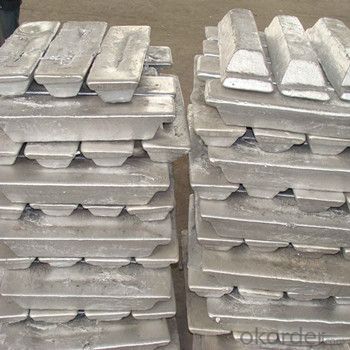

4.Aluminum Pig/Ingot Specification
Grade | Chemical Composition % | |||||||||
Al≥ | impurities ≤ | |||||||||
Si | Fe | Cu | Ga | Mg | Zn | Mn | others | Sum | ||
Al99.9 | 99.90 | 0.50 | 0.07 | 0.005 | 0.02 | 0.01 | 0.025 | - | 0.010 | 0.10 |
Al99.85 | 99.85 | 0.80 | 0.12 | 0.005 | 0.03 | 0.02 | 0.030 | - | 0.015 | 0.15 |
Al99.7 | 99.70 | 0.10 | 0.20 | 0.010 | 0.03 | 0.02 | 0.030 | - | 0.030 | 0.30 |
Al99.6 | 99.60 | 0.16 | 0.25 | 0.010 | 0.03 | 0.03 | 0.030 | - | 0.030 | 0.40 |
Al99.5 | 99.50 | 0.22 | 0.30 | 0.020 | 0.03 | 0.05 | 0.050 | - | 0.030 | 0.50 |
Al99.00 | 99.00 | 0.42 | 0.50 | 0.020 | 0.03 | 0.05 | 0.050 | - | 0.050 | 1.00 |
5.FAQ of Aluminum Pig/Ingot
We have organized several common questions for our clients,may help you sincerely:
①How about your company?
A professional factory which foucs on producing the aluminum pig,can meet customers' requiement to the quality and grade.The quality also have been accepted by customer.Already got the good reputation among the customers.It have gotten lot of much experience.The facrtory has the professional Technical Worker and the advanced equipments for production.Beside,it has the profesional teams to operate the whole proess for exporting.OEM service is availble and welcome.The items have beedn exported around the world,and have been acceptable among the customers,and have gotten the good reputation already.No matter from the quality,price and service,can be guaranteed for the cusgtomers.High purity and diffent grade are available.
②How to guarantee the quality of the products?
We have established the international advanced quality management system,every link from raw material to final product we have strict quality test;We resolutely put an end to unqualified products flowing into the market. At the same time, we will provide necessary follow-up service assurance.
③How long can we receive the prod rking days, We will arrange the factory delivery as soon as possible. The pecific time of receiving is related to the state and position of customers.Commonly 7 to 10 working days can be served.
- Q: How much is the price of the common aluminum sheet on the basis of the aluminum ingot? How much is the price of the broken aluminum alloy profile on the basis of the aluminum ingot?
- According to different manufacturers and brands, processing costs are slightly different, the general profiles of the higher processing costs, quality and material aspects can be guaranteed, small factories processing fees lower.
- Q: How are aluminum ingots melted?
- The typical method for melting aluminum ingots involves a process known as smelting. Smelting is when a metal is extracted from its ore by heating it to a high temperature, causing the metal to melt and separate from impurities. To accomplish the melting of aluminum ingots, a specially designed furnace is employed. This furnace is able to withstand the necessary high temperatures. The ingots are placed into the furnace and heated to temperatures ranging from 660°C to 780°C (1220°F to 1436°F). The furnace is usually fueled by natural gas, oil, or electricity. Once the ingots reach the desired temperature, they begin to melt and transition into a liquid state. At this stage, any impurities or foreign materials within the ingots separate and float to the top, forming a layer referred to as dross. The dross is then eliminated from the surface of the molten aluminum using various methods, such as skimming or specialized tools. After the removal of the dross, the molten aluminum is prepared for further processing or molding into different shapes. It can be poured into molds to create various products or refined further to meet specific requirements. The molten aluminum can also be combined with other metals to enhance its properties or mixed with additives to improve its strength, durability, or other desired characteristics. In summary, the process of melting aluminum ingots involves subjecting them to high temperatures in a furnace, causing them to melt into a liquid form, eliminating any impurities, and then carrying out additional processing or molding of the molten aluminum as necessary.
- Q: How are aluminum ingots used in the production of lighting fixtures?
- Due to their unique properties and versatility, aluminum ingots play a vital role in the manufacturing of lighting fixtures. The lightweight and durability of aluminum make it an ideal material for producing various components of lighting fixtures, such as the body, base, or frame. Its lightweight nature allows for easier installation and transportation, while its durability ensures the fixture's longevity. Furthermore, aluminum's excellent thermal conductivity is crucial for lighting fixtures as it helps dissipate heat generated by the bulbs. This property ensures that the fixture remains cool and prevents overheating, contributing to the safety and efficiency of the lighting system. Moreover, aluminum ingots can be easily molded into different shapes and sizes, allowing for the production of intricate and aesthetically pleasing lighting fixtures. This design flexibility enables manufacturers to cater to various consumer preferences, whether they prefer sleek and modern styles or classic and ornate designs. Moreover, aluminum's high corrosion resistance is particularly important for lighting fixtures that may be exposed to outdoor elements or high levels of moisture. This property guarantees that the fixture remains intact and maintains its appearance even under harsh conditions. Lastly, aluminum ingots are environmentally friendly as they can be easily recycled and have a low carbon footprint compared to other materials. This makes aluminum an appealing choice for lighting fixture manufacturers who prioritize sustainability and seek to reduce their environmental impact. In conclusion, the lightweight, durable, and thermally conductive properties of aluminum ingots, along with their versatility in design and environmental friendliness, make them indispensable in the production of lighting fixtures.
- Q: How is the price of aluminum ingots determined?
- Various factors in the global market determine the price of aluminum ingots. The price is greatly influenced by the demand for aluminum, which is used in industries such as automotive, construction, aerospace, and packaging. Moreover, the availability of aluminum ore, extraction and refining costs, and any changes in production costs such as energy or labor expenses can impact the final price. Economic factors also play a role, with periods of economic growth leading to increased demand and higher prices, while economic downturns can result in decreased demand and lower prices. In addition, the price of aluminum ingots can be affected by the global trade environment, including tariffs and import/export regulations. Government policies such as subsidies or taxes on aluminum production can also have an impact. Furthermore, speculators and investors in the commodities market can cause short-term fluctuations in aluminum ingot prices. Speculative trading, based on anticipated changes in supply and demand or geopolitical events, can temporarily drive prices up or down. Considering all of these factors, the price of aluminum ingots is determined through a complex interaction of supply, demand, production costs, market conditions, trade policies, and speculative trading.
- Q: What are the advantages of using aluminum ingots in the production of consumer electronics?
- Using aluminum ingots in the production of consumer electronics offers numerous benefits. Firstly, aluminum is lightweight, making it perfect for portable devices. This allows for easy handling and transportation, enhancing convenience for consumers. Secondly, aluminum is highly durable. Its exceptional strength-to-weight ratio enables it to withstand stress without compromising its structure. As a result, consumer electronics made from aluminum ingots are less likely to break or sustain damage, ensuring long-lasting and reliable performance. Thirdly, aluminum's high thermal conductivity facilitates efficient heat dissipation. This property is particularly useful for consumer electronics that generate heat during operation. Proper heat management prevents overheating, ensuring optimal device performance. Moreover, aluminum possesses natural corrosion resistance. Its surface forms a protective oxide layer, making it suitable for consumer electronics exposed to moisture or humidity. This safeguard shields internal components from damage, prolonging device lifespan. Furthermore, aluminum's sleek and modern appearance enhances the aesthetics of consumer electronics. It can be easily molded into various shapes and sizes, enabling sleek designs that appeal to consumers who value visual appeal. Lastly, using aluminum ingots promotes environmental sustainability. Aluminum is highly recyclable, reducing the need for extracting and processing raw materials. This conserves energy and minimizes environmental impact compared to materials like plastic or steel. In summary, the advantages of employing aluminum ingots in the production of consumer electronics encompass lightweight portability, durability, effective heat dissipation, corrosion resistance, attractive aesthetics, and environmental sustainability.
- Q: How are aluminum ingots used in the production of sports equipment?
- Aluminum ingots are used in the production of sports equipment primarily because of their lightweight and durable properties. They are commonly utilized to make components such as frames, handles, and shafts for various sports equipment like bicycles, tennis rackets, golf clubs, and baseball bats. The use of aluminum ingots allows for better maneuverability, improved performance, and increased strength-to-weight ratio in these sporting goods.
- Q: What is the aluminum ingot smelting
- Aluminum is a commonly known as recovery. Aluminum is a chemical element. Its chemical symbol is Al, and its atomic number is 13. Aluminum is the third largest in the earth's crust, second only to oxygen and silicon, and is the most abundant metal element in the earth's crust. Among the metal varieties, second only to steel, they are the second major metals. Until the end of nineteenth Century, it has become the competitive aluminum made in the engineering application of the metal, and come into fashion. Aluminum is widely used in construction, automotive, aviation, the development of three major industries, the unique properties of material properties of aluminum and its alloys, which greatly facilitates the production and application of recycled aluminum metal.
- Q: What kind of material is die casting aluminium ingot?
- Product (Unwrought). Products obtained by smelting (or refining) and casting. For example, rolled ingots, extruded ingots, wrought ingots, and remelting ingots
- Q: How are aluminum ingots used in construction?
- Aluminum ingots are widely used in the construction industry for various applications due to their excellent properties and versatility. One common use of aluminum ingots in construction is for the manufacturing of structural components such as beams, columns, and trusses. The lightweight nature of aluminum makes it an ideal choice for these applications as it reduces the overall weight of the structure, leading to cost savings in transportation and installation. Additionally, aluminum ingots are used in the production of cladding systems, which are used to cover the exterior of buildings. These cladding systems provide aesthetic appeal, weather protection, and insulation to the structure. Aluminum's corrosion resistance and durability make it a preferred material for cladding, as it can withstand harsh weather conditions and maintain its appearance over an extended period. Moreover, aluminum ingots are employed in the fabrication of windows, doors, and curtain walls in construction projects. Aluminum frames offer strength and stability while providing a sleek and modern aesthetic. The material's corrosion resistance also ensures that these components remain durable and low-maintenance for a long time. Furthermore, aluminum ingots find applications in roofing systems. Aluminum roofs offer excellent resistance to corrosion, as well as being lightweight and durable. They are also highly reflective, which helps to reduce heat absorption and energy consumption, making them a sustainable choice for buildings. In conclusion, aluminum ingots play a crucial role in the construction industry. Their lightweight nature, corrosion resistance, and durability make them an excellent choice for structural components, cladding systems, windows, doors, curtain walls, and roofing systems. The use of aluminum ingots in construction not only enhances the overall aesthetics of the building but also contributes to its longevity, energy efficiency, and sustainability.
- Q: How are aluminum ingots used in the production of aerospace components?
- The unique properties and characteristics of aluminum ingots make them crucial for aerospace component production. Melting and refining these ingots creates high-quality aluminum alloys designed specifically for the demanding requirements of the aerospace industry. Aluminum is widely used in aerospace manufacturing for several reasons. Its low density reduces the overall weight of aircraft, resulting in improved fuel efficiency and increased payload capacity. This is especially important in aerospace, where saving even a kilogram leads to significant cost savings and operational advantages. Another advantage of aluminum ingots is their excellent strength-to-weight ratio. By combining aluminum with elements like copper, magnesium, or zinc, aerospace engineers can create strong alloys while maintaining a low weight. These alloys are used to manufacture components like airframes, wings, fuselage sections, and structural supports that need to withstand extreme conditions and stresses during flight. Furthermore, aluminum ingots offer exceptional corrosion resistance, making them ideal for aerospace applications. Aircraft endure harsh environments with moisture, saltwater, and temperature fluctuations. The natural oxide layer on aluminum alloys derived from these ingots provides a protective barrier against corrosion, ensuring the longevity and durability of aerospace components. Additionally, aluminum ingots can be easily cast, machined, and formed into intricate shapes and designs, allowing for the production of complex aerospace components with high precision. This versatility is crucial in the aerospace industry, where specific needs and requirements of different aircraft models must be met. In conclusion, aluminum ingots are essential for aerospace component production due to their lightweight nature, excellent strength-to-weight ratio, corrosion resistance, and versatility in manufacturing processes. By utilizing these ingots and their derived alloys, aerospace manufacturers can achieve a perfect balance between performance, durability, and efficiency in their aircraft, contributing to the advancement and safety of the aerospace industry.
Send your message to us
Aluminum Pig/Ingot Sold With Wholesale By Mills
- Loading Port:
- China main port
- Payment Terms:
- TT OR LC
- Min Order Qty:
- 1000 m.t.
- Supply Capability:
- 100000 m.t./month
OKorder Service Pledge
OKorder Financial Service
Similar products
Hot products
Hot Searches

